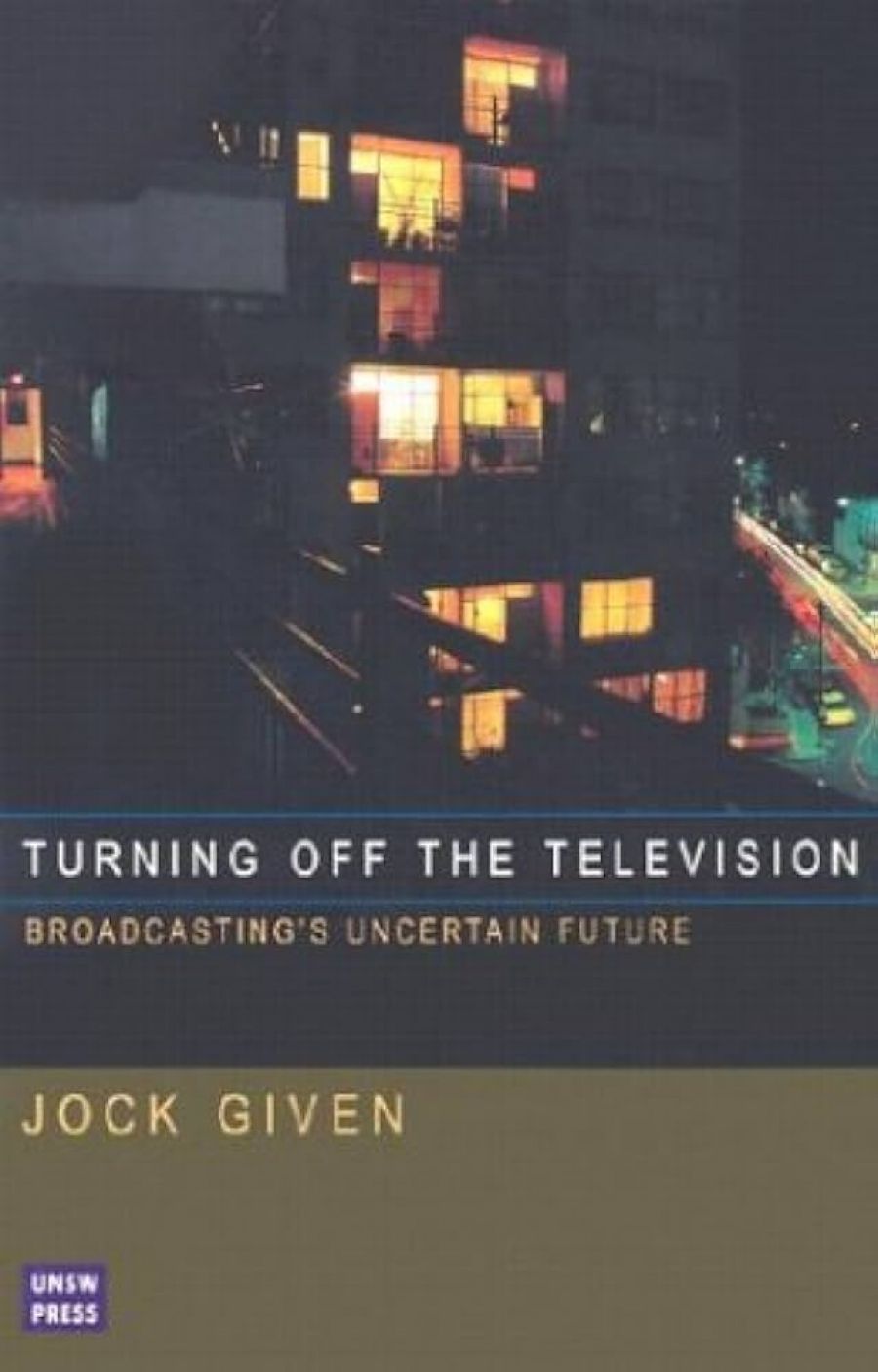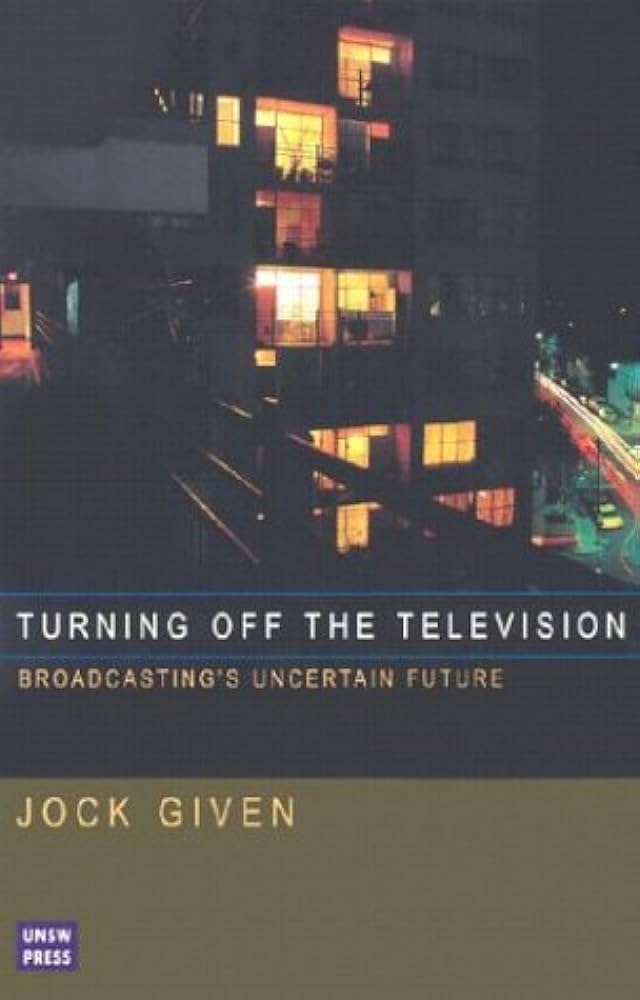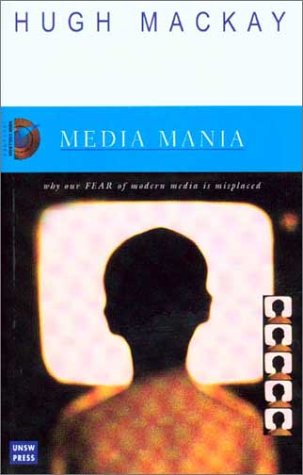
- Free Article: No
- Contents Category: Media
- Review Article: Yes
- Article Title: Screen Tests and Digital Dead-ends
- Online Only: No
- Custom Highlight Text:
At a recent Australian Broadcasting Authority conference, federal communications minister Senator Richard Alston conceded that the early adoption of digital television in Australia had been ‘modest’. More impartial observers of the transition to digital broadcasting in Australia have been less restrained. ‘A digital dead-end’ and ‘dismal failure’ are representative of recent media commentary on the subject.
- Book 1 Title: Turning off the Television
- Book 1 Subtitle: Broadcasting’s uncertain future
- Book 1 Biblio: UNSW Press, $44.95pb, 342pp
- Book 1 Cover Small (400 x 600):

- Book 1 Cover (800 x 1200):

- Book 2 Title: Media mania
- Book 2 Subtitle: Why our fear of modern media is misplaced
- Book 2 Biblio: UNSW Press, $24.95pb, 96pp
- Book 2 Cover Small (400 x 600):

- Book 2 Cover (800 x 1200):

In mid-1998 the federal government made its first round of decisions about the introduction of digital television and set 1 January 2001 as the date for the commencement of digital broadcasting in metropolitan Australia. Its current plan is to turn off analogue television signals between 2008 and 2011, by which time it hopes that all households will have either a digital television or at least a digital set-top box decoder in order to receive the new service. Thus far, there is little to suggest that this hope will be realised. Australians are not embracing the new technology – two years after its launch, only about 75,000 Australian homes receive digital television – and the recent axing of the ABC’s two digital channels, FLY TV and ABC Kids, was another indication of its halting progress.
Jock Given, however, is optimistic. Turning Off the Television discusses the technical, commercial and policy choices already made about digital broadcasting, and examines their implications. As much about the past as the future, this comprehensive study traces the technological changes that have led to the so-called digital revolution, from Marconi to the dot-com crash.
Given argues that the transition to digital services is ‘less a moment of technical upgrade, and more a potentially long evolution’. He is positive about what digital transmission offers: a transformation in the range and nature of television services, and the vacation for other purposes of the radio frequency spectrum currently used for analogue television. But he is also clear about the potential dangers, including the possibility that important economic and social principles will be compromised to enable choices already made about digital broadcasting to ‘work’; that competition and diversity in the Australian media will be sacrificed; and that governments anticipating the revenue that might flow from re-auctioning the analogue spectrum will be more dedicated to the plan to turn off analogue services than the viewers who will incur most of the costs. And there are plenty of critics, Given observes, for whom the end of analogue television will not come too soon: people who see television as a major contribution to the decline of ‘civic engagement’.
Social researcher High Mackay might agree with the critics, but not with any suggestion that media content is to blame for Mackay’s Media Mania – a reworking of his series of New College lectures, delivered at the University of New South Wales in 2001 – challenges the view that mass media content is responsible for the problems that beset modern society.
The frequently repeated assertion that television, in particular, has created a more violent and morally bereft society is misplaced, argues Mackay, because it wrongly assumes that the mass media exercise greater power over us than we do over each other. A widespread belief in ‘the hypodermic effect’, the idea that the media are like giant syringes capable of injecting a mass audience in a single dose, has produced a kind of media mania that generates fear and leads to a dangerous assumption that the media’s power is insidious and beyond our understanding or control. And it is not only the ignorant masses who are convinced of its potency. Politicians seize every opportunity to utilise the media to their ends, and church leaders have long toyed with the idea of using the media to spread the gospel. They are all misguided, according to Mackay, because the media do not shape our attitudes and values directly. Rather, they reinforce pre-existing attitudes and satisfy our needs, whether for stimulation, tranquilisation or merely affirmation of our views. The reception of media content is almost invariably mediated by other factors, and it is only in rare instances where those factors are inoperative that the media can have a direct impact on attitude formation.
Mackay’s book examines in turn those aspects of the modern media around which claims about media influence have revolved: television advertising, media violence, the Internet, and the current trend towards lifestyle programs. Advertising, which appears to be the most overt form of television propaganda, is found to be greatly overestimated in its ability to influence consumers. Most new products fail, and in those cases where advertising has been credited with significantly increasing a product’s share of the market, the campaigns have merely reinforced existing inclinations towards that product. The effect of alcohol advertising on consumption rates is negligible, argues Mackay, pointing to a study that showed a consistent decline in consumption despite a massive increase in advertising expenditure. And the influence of political advertising is also minimal. The Australian Labor Party’s ‘It’s Time’ campaign in 1972 was deemed to have been so powerful that it won the federal election and put the ALP in office after decades in the political wilderness. But according to Mackay, rather than persuading voters it was time to change, it simply stated what they had already come to believe, and encouraged them to act on that belief.
Mackay is slightly more nuanced on the subject of media violence. He challenges the conventional wisdom that there has been an increase in juvenile aggression and that it is fuelled by children’s exposure to media violence. He argues that children need to have a predisposition to violent behaviour to be receptive to violence in the media. He cites several studies that point to socio-economic factors as the principal causes of violence, notably a 2001 study of violence against Aboriginal women and children. And he shows that the group most likely to perpetrate violence – young males – are also the lightest television viewers in the country. Laboratory experiments attempting to establish a causal link between media violence and violent behaviour are flawed, chiefly because they are not real-life situations. However, Mackay does concede the ‘copycat’ effect engendered by television violence, and identifies another kind of media violence: isolation from society brought about by heavy television viewing and internet use. The notion that the internet has created a ‘global village’ is a ‘huge hoax’, he argues. Cyberspace intimacy is a poor substitute for physical human interaction.
The theoretical framework of Mackay’s thesis is not new. The view that the media contribute to attitude formation rather than shaping it directly has prevailed for at least forty years. Mackay’s achievement is to present it in an accessible and appealing manner.
But he has painted an incomplete picture. Media violence is not limited to graphic images of murder and rape on television screens. As columnist Phillip Adams has recently argued, the mass media are also the instigators of ‘corporate’ forms of violence such as the sexualisation of children. Aggressive marketing and certain forms of entertainment such as eroticised music videos encourage children to regard themselves as sexual beings long before they reach adolescence. What is the moral distinction, asks Adams, between sex tours to Asia, where paedophiles buy young bodies, and the use of thirteen-year-old girls as fashion models in glossy magazines?
It is this broader conception of media influence that is lacking in Mackay’s book, notwithstanding his contention that the media themselves, rather than their content, are to blame for society’s ills. Yes, the issues are extraordinarily complex, and the available evidence seems to suggest that clichéd assertions about the media’s adverse effects are unfounded – at this stage. But let’s not kid ourselves that the mass media have a benign impact on social behaviour and mores.
At a time of intense debate in Australia about media ownership laws, the funding of the ABC and SBS, and the transition to digital broadcasting, both of these books make a valuable and important contribution to our understanding of media practices and influences.


Comments powered by CComment